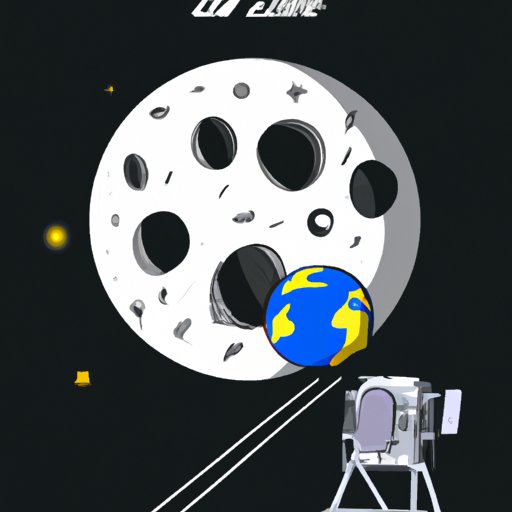Introduction
The idea of space exploration has captivated humanity for centuries. In 1969, this notion seemed almost impossible until three brave astronauts set out on a mission to the moon. The Apollo 11 mission marked the first successful journey to the moon and changed the course of history. But just how long did it take for these brave explorers to make their historic journey? This article will explore the duration of space travel to the moon by taking a chronological look at the Apollo 11 mission and later missions, examining the time required to reach lunar destinations, and comparing past and present journeys.

A Chronological Account of How Long It Took for Astronauts to Reach the Moon
Before the Apollo 11 mission, there had been several attempts at space travel. The Soviet Union launched the first satellite, Sputnik 1, in 1957 and sent the first human into space in 1961 with cosmonaut Yuri Gagarin. The United States followed suit in 1962 when astronaut John Glenn became the first American to orbit Earth.
The Apollo 11 mission was launched on July 16th, 1969 from the Kennedy Space Center in Florida. It was the fifth manned mission of the Apollo program, with Commander Neil Armstrong, Command Module Pilot Michael Collins, and Lunar Module Pilot Edwin “Buzz” Aldrin aboard. After a four-day journey, the mission reached its destination on July 20th and Armstrong became the first person to walk on the moon. The total time it took to reach the moon was approximately 76 hours, or 3 days and 4 hours.
Later missions also achieved success, with the Apollo 12 mission reaching the moon five months after Apollo 11. The Apollo 13 mission, however, faced difficulties due to an explosion onboard and had to be aborted. It still managed to reach the moon, but the trip took longer than expected—over 91 hours. Apollo 14 through 17 all successfully reached the moon, with some taking slightly longer or shorter trips depending on their trajectories.

Exploring the Journey: Calculating the Time Required to Reach Lunar Destination
The duration of a journey to the moon depends on several factors such as the spacecraft’s trajectory, launch date, and speed of travel. To accurately calculate the time required, scientists use different methods, including the Lambert’s problem, which is a mathematical equation used to determine the path and time of a spacecraft traveling between two points in space.
The time required to reach the moon also depends on the type of spacecraft being used. For example, the Apollo 11 mission used the Saturn V rocket, which was designed to carry heavier payloads and travel faster than earlier rockets. With this rocket, the mission was able to reach the moon in around three days.
The Race to the Moon: Examining the Timeline of Space Travel
The timeline of space travel has seen many notable firsts. In 1957, the Soviet Union launched the first satellite, Sputnik 1. This was followed by the launch of the first human into space in 1961 and the first American to orbit Earth in 1962. The first unmanned mission to the moon was conducted by the Soviets in 1959, and in 1966, the United States sent the first spacecraft to soft land on the moon.
After the first successful mission to the moon, the race to space intensified. In 1971, the Soviets launched the first orbital space station, Salyut 1, followed by the US launching the first space shuttle in 1981. In 1986, the Challenger disaster marked a turning point in the space race, but it didn’t stop progress. In 1990, the Hubble Space Telescope was launched and in 1998, the International Space Station was established.

Past and Present: Comparing the Duration of Space Travel to the Moon
The Apollo 11 mission took about 76 hours to reach the moon, but modern day space travel has made the journey much faster. According to NASA, the current journey time to the moon is only three days. This is thanks to technological advancements such as more efficient engines, improved navigation systems, and more accurate tracking of the spacecraft’s position.
The Apollo 11 mission was also limited by the technology available at the time. The spacecraft had to adhere to a specific trajectory in order to reach its destination, whereas today’s spacecraft can take advantage of more advanced propulsion systems and celestial mechanics to adjust their paths mid-flight.
The Science Behind the Trip: Understanding the Physics of Lunar Exploration
To understand the science behind the trip to the moon, it’s important to understand escape velocity. This is the speed required for an object to break free from the gravitational pull of a larger body and reach a higher orbit. The Apollo 11 mission had to reach escape velocity of 11.2 kilometers per second to leave Earth’s atmosphere and reach the moon.
Newtonian mechanics also played a role in the mission. Newton’s laws of motion describe how objects move in response to forces acting upon them. By understanding these laws and applying them to the spacecraft, scientists were able to calculate the trajectory and time required to reach the moon.
Conclusion
In conclusion, this article has explored the duration of space travel to the moon. It has taken a chronological look at the Apollo 11 mission and subsequent missions, examined the time required to reach lunar destinations, and compared past and present journeys. It has also discussed the science behind the trip and the forces involved in escaping Earth’s gravitational pull. The Apollo 11 mission marked a monumental moment in history, and it is incredible to think that the same journey now takes only three days.
(Note: Is this article not meeting your expectations? Do you have knowledge or insights to share? Unlock new opportunities and expand your reach by joining our authors team. Click Registration to join us and share your expertise with our readers.)
